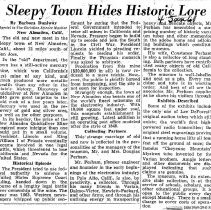Archive Record
Images

Metadata
Catalog number |
1997.2.1757 |
Object Name |
Clipping, Newspaper |
Date |
1961 |
Description |
TITLE: Sleepy Town Hides Historic Lore AUTHOR: Barbara Duniway PUBLISHER: The Christian Science Monitor New Almaden, Calif. Jan 4, 1961 The old and new meet in the sleepy town of New Almaden, Calif., about 12 miles south of San Jose. In the "old" department, the ,town has a still-active mercury mine, which was California's first mine of any kind, and which produced more metallic wealth than any other in the State's history. Discovery of quicksilver at New Almaden in 1845 gave great impetus to the gold rush of a few years later. Mercury was used in the recovery of gold and silver ores, as well as for other purposes. In its heyday, the prize of the New Almaden Quicksilver Mine inspired more intrigue than one could put in a small volume. President Lincoln and King William I of Prussia eventually became involved in one legal battle which threatened to lose California and Nevada for the United States. Historical Episode The President tried to use federal authority to enforce a United States Supreme Court ruling, handed down in the course of a lengthy legal battle over ownership of the mine. The year was 1863. Western newspapers whipped up public sentiment by saying that the Federal Government- intended to seize all mines in California and Nevada. Pressure began to build up to secede and join the South in the Civil War. President Lincoln yielded to pleading requests to rescind his order. Finally, the Prussian monarch was asked to arbitrate. Production from this mine ($50,000,000 in all) is now reduced to a mere trickle. However, the public is strictly barred from trespassing, and the site is not open for inspection. Strangely enough, the town of New Almaden also boasts one of the world's finest museums of the electronics industry. With 10,000 square feet under roof, this nonprofit establishment is still growing. Latest addition is an operating post office modeled after the style of 1849. Collecting Partners This, strange marriage of old and new is reflected in the personalities of the managers of the museum, Mr. and Mrs. Douglas Perham. Mr. Perham, pioneer engineer and financier in the early beginnings of the electronics industry in Palo Alto, Calif. is also by proclivity, a collector. Through his many friends in Varian, Dalmo-Victor, Hewlett-Packard and other firms; and through his untiring energy in transporting heavy and delicate objects, Mr. Perham has assembled a surprising number of historic vacuum tubes and other mementos, in the adobe home and adjoining buildings which constitute the museum. His wife, Constance Perham, is also a collector of long standing. Both partners have contributed many objects of old California to the collection. The museum is well-labeled and neat as a pin. Every ma-chine and tube is in working order. And best of all are the anecdotes Mr. Perham supplies as he shows his visitors through. Exhibits Described Some of the exhibits include the only one of Lee DeForest's original audion tubes which still exists; the world's first high-powered radio transmitter; the original steel engravings proving that a running horse lifts all four feet off the ground at once; the famous "Cheyenne Mountain" klystron tube invented by the Varian brothers. Ample letters and other documents, are displayed indicating that such claims are genuine. The museum, with its extensive slide collection, is at the service of schools, scholars, and other educational groups. It is open to the public every day except Monday. There is a small charge to cover costs of operation. |
People |
Lincoln, Abraham Perham, Constance (Mrs. Kambish) Perham, Douglas M. |
Cataloged by |
Boudreault, Art |
